双语:十大科学欺诈和骗局
很多科学家可以通过惊人或独特的发现而赢得名誉和金钱,并且如果这一发现可以激发一项好研究的话,那将会被滥用。本文列出了十件愚弄了很多人的科学诈骗。也许这也能提醒人们该对某些科学“发现”持保留意见。
A lot of fame and money can be made by scientists who make amazing or unique discoveries, and while this generally provides a motivation for good research, it is occasionally abused. This is a list of 10 cases of scientific fraud that fooled many people. Perhaps this can serve as a reminder that some scientific “discoveries” need be taken with a grain of globally warmed salt.
十
J.H.舍恩 (Jan Henrik Schön)

舍恩(图左)是新泽西州贝尔实验室的一位研究员。1998年到2001年间,他曾在《自然》上刊登过五篇论文,在《科学》期刊上刊登过七篇文章,都是有关于电子学的高级领域。他的发现很深奥,但还是被同仁们视为正在升起的新星。
2002年,委员会发现他的结果是从16个偶然里得出的,这使得他的同事、老板、以及承认他结果的两本期刊编辑人员都遭受了公众尴尬。
当时仅32岁的舍恩说:“我承认我在科学工作中犯了很多错误,并且对此感到非常的后悔。”《自然》杂志也补充说明道:“我真的相信所报道的科学结果是真实、刺激并值得为之奋斗的。”他不会再说什么了。
Jan Henrik Schön (pictured on the left), a researcher at Bell Laboratories in New Jersey, had five papers published in Nature and seven in the journal Science between 1998 and 2001, dealing with advanced aspects of electronics. The discoveries were abstruse, but he was seen by many of his peers as a rising star.
In 2002, a committee found that he had made up his results on at least 16 occasions, resulting in the public embarrassment of his colleagues, his employer, and the editorial staffs of both the journals that accepted his results.
Schön, who by then was still only 32, said: “I have to admit that I made various mistakes in my scientific work, which I deeply regret.” Nature also reported him as adding in a statement, “I truly believe that the reported scientific effects are real, exciting and worth working for.” He would say no more.
九
卡蒂夫巨人 The Cardiff Giant
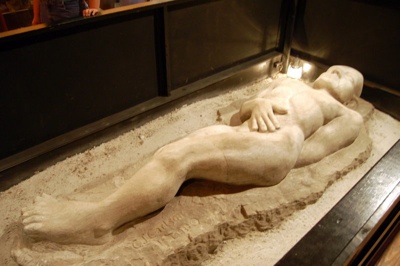
卡蒂夫巨人是美国历史上最有名的骗局之一。这是一具长3米(合10英尺)的石化体,由一队工人于1869年在纽约卡蒂夫的威廉·纽威尔(William Newell)家后面挖井时发现的。事后证明,该巨人由一名叫乔治·霍尔(George Hull)的纽约无神论者制作。他当初做这个巨人是为了取笑正统派基督教牧师塔克先生(Mr. Turk),因为塔克牧师相信圣经所说的地球有巨人的说法。
巨人越来越受欢迎,以致PT巴诺姆(P T Barnum)愿支付6万美金来租三个月,但遭拒绝,因此他做了个复制品展出。当他的复制品比真品更受欢迎时,“真正”造假品的主人开始起诉巴诺姆。法官驳回诉讼并指出,除非原告可以证明自己的是真品,否则巴诺姆仿造自己的赝品将是无罪的。
The Cardiff Giant is one of the most famous hoaxes in American history. It was a 3 meter (10 foot) petrified body of a man. It was discovered in 1869 by a team of workers digging a well behind the home of William Newell in Cardiff, New York. As it turns out, the giant was the creation of a New Yorker named George Hull, an atheist, who decided to create the giant as a joke on fundamentalist minister Mr Turk who believed that the Bible told of literal giants who roamed the earth.
The giant became so popular that P T Barnum offered $60,000 for a 3 month lease of it. He was turned down so he had a replica made which he put on display. When his replica became more popular than the original, the owner of the “authentic” fake tried to sue Barnum. The judge threw the lawsuit out stating that unless the original could be proven to be real, there was nothing wrong with Barnum producing his own fake.
八
永动机 The Perpetual Motion Machine
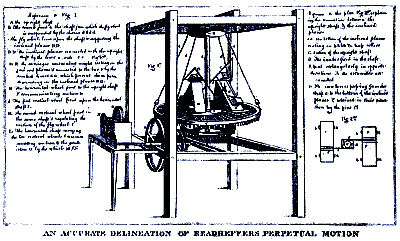
靠水和产能比耗能多的熔化器启动的汽车,是发明者们幻想的主要产物。他们总是会出现。查尔斯·李德黑法(Charles Redheffer)凭永动机在费城筹集了巨款,又于1813年将它带到纽约,数百人都花一美元来看该机器。
它看上去似乎真的能使自己运转。最后,怀疑派给李德黑法一笔巨款,让他们去“证明”该机器事实上是个骗局。李德黑法拿了钱后,怀疑派便开始将靠墙的木条从机器抽离,当他们这么做时,发现一条绳子,穿过墙通往阁楼,而阁楼里有一个老人正一手转动曲柄,一手啃着面包。
Cars that run on water and fusion machines that generate more energy than they use are staples of inventors’ fantasy. They pop up all the time. Charles Redheffer raised large sums of money in Philadelphia with a perpetual motion machine and then took it to New York in 1813, where hundreds paid a dollar each to see it.
It did, indeed, seem to keep itself turning. In the end, skeptics offered a large sum of money to “prove” that the machine was in fact a fraud. Redheffer took the money and the skeptics removed some wooden strips along the wall from the machine. When they did so, they found a cat-gut belt drive, which went through a wall to an attic where an old man was turning a crank with one hand, and eating a loaf of bread with the other.
七
躺着的石头 The Lying Stones
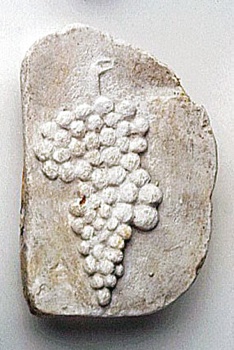
1726年,维尔茨堡的约翰·柏林格(Johann Beringer)发表了他在巴伐利亚镇外发现化石的细节。其中涉及“皮肤上的蜥蜴纹、长喙和眼的鸟、带网的蜘蛛、交配的青蛙”等内容。他发现的其它石头还刻有希伯来字母YHVH,意为耶和华或上帝。他相信它们是无机世界“塑料能量”的天然产物,并在书中也如是说。
事实上,这些化石是恶意的同事骗着他埋下的。传说柏林格自己因竭力买自己的出版物而穷困潦倒,而他的发现也被称作Lugensteine而闻名,或称其为“躺着的石头”。那些设计骗局的同事则既丢了工作又因丑闻毁了名声。
In 1726, Johann Beringer of Würzburg published details of fossils found outside the Bavarian town. These included “lizards in their skin, birds with beaks and eyes, spiders with their webs, and frogs copulating.” Other stones he found bore the Hebrew letters YHVH, for Jehovah, or God. He believed them to be natural products of the “plastic power” of the inorganic world, and said so in a book.
In fact, they had been planted fraudulently by spiteful colleagues. The legend is that Beringer impoverished himself trying to buy back all copies of his book, and the finds became known as lügensteine, or “lying stones”. The colleagues who perpetrated the hoax lost their jobs and reputations over the scandal.
六
塔萨代族(The Tasaday Tribe)

1971年,一位菲律宾政府官员马纽尔·伊里杂德(Manuel Elizalde)发现了一个石器时代与世隔绝居住于棉兰老岛的小部落。此部落叫塔萨代,说先进语言,用石头器具,并显示出其他石器时代的特征。他们的发现马上成为电视的头条新闻、国家地理杂志的封面、以及一本畅销书的主角。当人类学家们试图对这一部落做进一步研究时,总统马科斯(Marcos)宣布保留这片土地并禁止任何人进入。
当马科斯1986年卸任后,两名记者走访了该地,并发现塔萨代人其实住在房子里,与当地农民做贸易,穿牛仔裤和T恤衫,并操一口现代的当地方言。塔萨代人解释说,他们是受伊里杂德的压迫才住进山洞并表现出石器时代的样子的。伊里杂德1983年逃离出国,并偷了保护塔萨代人基金组织的上百万美元。
In 1971, a Philippine government minister (Manuel Elizalde) discovered a small stone age tribe living in isolation on the island of Mindanao. This tribe, called the Tasaday, spoke a strong language, used stone tools, and exhibited other stone-age attributes. Their discovery made television headlines, the cover of National Geographic, and was the subject of a bestselling book. When anthropologists tried to get a better look at the tribe, President Marcos declared the land a reserve and made it off-limits to all visitors.
When Marcos was deposed in 1986, two journalists visited the site and found that the Tasaday in fact lived in houses, traded with the local farmers, wore jeans and t-shirts and spoke a modern local dialect. The Tasadays explained that they had moved in the caves and behaved in a stone-age manner because of pressure from Elizalde. Elizalde had fled the country in 1983 with millions of dollars he had stolen from a foundation set up to protect the Tasaday people.
五
藤村新一的发现 Discoveries of Shinichi Fujimura
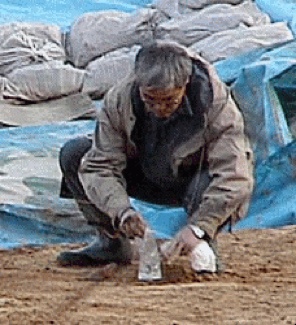
尽管是自学,藤村新一仍是日本主要的考古学家之一。1981年他第一次发现了可追溯至四万年前的瓷器,这是当时日本发现的最古老的瓷器,从此他的事业如日中天。在接下去的几年里,他发现了越来越古老的史前古器物,并推动了日本所知先史学的界限。
2000年10月,藤村新一又发现了一组石器,并被认为是原始人类所做,他们还发现了可以证明为原始人居住地的一些山洞。该发现被认为具有60万年的历史,是全世界人类居住的最古老标志。至此,这一发现的范围开始国际化。
接着,11月5日,每日新闻报在首页刊登了三张照片,照片显示藤村在一个地方挖洞,将史前古器物埋进去后又挖出来(如上图所示)。在那天的新闻发布会上,他承认他曾经将石器埋起来并伪造了多项发现。他羞愧地低下头,说道:“我是受了魔鬼的诱惑。”
Shinichi Fujimura was one of Japan’s leading archaeologists - despite being self-taught. In 1981 he made his first discovery of stoneware that dated back 40,000 years. It was the oldest stoneware ever found in Japan and this discovery launched his career. During the following years he discovered older and older artifacts that pushed the limits of Japan’s known pre-history.
On October, 2000, Fujimara discovered a cluster of stone pieces that they believed to have been made by primitive people; they also found several holes that they claimed were to hold supports for primitive dwellings. The find was believed to be over 600,000 years old - making the oldest signs of human habitation in the world. This lead to international coverage.
Then, on November 5, the Mainichi Shimbun newspaper published three photos on the front page, which showed Fujimara digging holes at the site and burying the artifacts that he later dug up (see image above). At a press conference that day he admitted that he had planted the stones and had faked most of his discoveries. With his head bowed in shame, he said: “I was tempted by the Devil.”
四
伟大的月球 The Great Moon Hoax
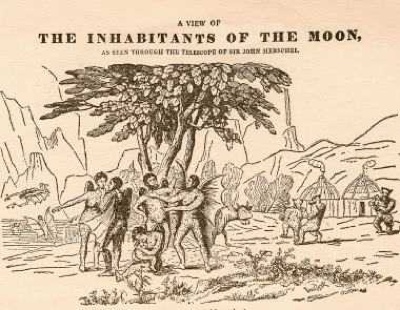
1835年8月,纽约太阳报的首页刊登了几篇文章,其中列出了一系列不可思议的天文学突破,这些突破都是由英国天文学家约翰·赫舍尔(John Herschel)使用一种特制的大望远镜和特殊方法所活得。文章说赫舍尔已经发展了“彗星现象的新理论”,发现了其他星系的星球,而且他已经“解决并更正了几乎每个数理天文学的主要问题”。文章随后提道了赫舍尔最令人震惊的成就:他发现月球上有智慧生命的存在。
他描述了月球表面广阔的森林、海洋和淡紫色的金字塔,以及漫游平原的野牛群和居住山顶的独角兽。
文章当然是个精心设计的骗局。赫舍尔既没有观察过月球上的生命,也没有完成他授予自己的天文学上的成就。事实上,事后证明赫舍尔甚至不知道归功于他的一些成就。尽管如此,太阳报仍然继续刊登这一类文章,直到公众意识到这是一场骗局。
In August, 1835, a series of articles appeared on the front page of the New York Sun. The articles listed a series of incredible astronomical breakthroughs that the British Astronomer, Sir John Herschel, had made using a unique large telescope and special methods. The article said that Herschel had developed a “new theory of cometary phenomena”; he had discovered planets in other star systems; and he had “solved or corrected nearly every leading problem of mathematical astronomy.” The article then mentioned Herschel’s most stunning achievement: he had discovered intelligent life on the moon.
三
拉马克的遗传学 Lamarckian Inheritance
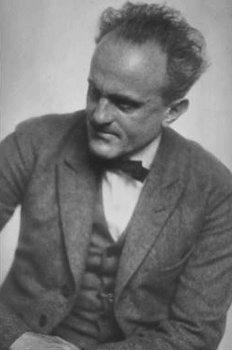
20世纪20年代,一位叫保尔·卡摩尔(Paul Kammerer)的奥地利科学家做了个实验,以证明拉马克遗传学(认为生物体有特征并会遗传给他们的后代)的可能性。他的实验由一种被称为产婆蟾的蟾蜍完成。多数蟾蜍在水中交配,这就使得后腿上的黑色鳞状突起物可以抓在其它蟾蜍的身上以进行交配,而产婆蟾则在陆地上完成,因为没有这类的突起物。卡摩尔说,让产婆蟾在水中进行交配,他能证明它们也能长出这样的突起物。
卡摩尔在盛满水的鱼缸里交配了好几代的蟾蜍,最后他宣布他成功了,并展示了一组带有黑色指垫的产婆蟾。
然而,1926年,G.K诺贝尔博士(Dr G.K.Noble)研究这个有名的蟾蜍时发现,黑色指垫其实是注入蟾蜍后退的黑色墨水。当骗局在1926年被揭穿时,卡摩尔感到非常的丢脸,并坚持说自己并没有在蟾蜍腿上注入墨水,声称可能是他其中一名实验室助手所为。几天后,卡摩尔便自杀了。
During the 1920s an Austrian scientist named Paul Kammerer designed an experiment to prove that Lamarckian inheritance (the notion that organisms may acquire characteristics and pass them to their offspring) was possible. His experiment involved a species of toad called the Midwife Toad. Most toads mate in water - resulting in scaly black bumps on their hindlimbs which allow them to hold on to each other during mating, but the midwife toad mates on land - and therefore does not have these lumps. Kammerer said that by forcing midwife toads to mate in water, he could prove that they would develop the same bumps.
Kammerer mated a number of generations of toads in a fishtank full of water. Eventually he announced that he had succeeded and he presented a group of midwife toads with black bumps on their hindlimbs.
However, in 1926, Dr G. K. Noble studied the famous toads and discovered that the black bumps were in fact ink that had been injected in to the hind legs of the toads. When the fraud was unveiled in 1926, Kammerer was humiliated. He insisted that he had not injected ink into the toads and suggested that one of his lab assistants might have done it. Kammerer committed suicide a few days later.
二
索卡事件 The Sokal Affair
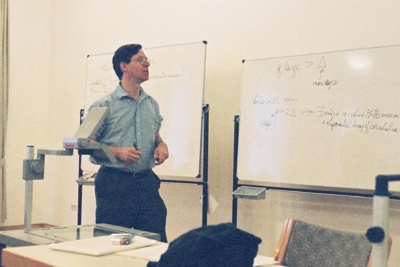
索卡时间是阿兰·索卡(Alan Sokal,物理学家)通过后现代文化研究杂志《社会文本》(杜克大学(Duke University)出版)设计的骗局。1996年,他向杂志社投了篇用术语伪装的荒唐文章,想看看杂志社是否“会发表这么一篇充满荒唐思想的文章,如果这篇文章听上去不错,并且迎合编辑们意识形态的预想”。
文章《跨越界线:通往量子力学重力理论的转换诠释学》(Transgressing the Boundaries: Toward a Transformative Hermeneutics of Quantum Gravity)那一年被刊登在“科学战争”里。 文章发表当天,索卡在另一篇论文里宣布,这篇文章是个骗局。他说《社会文本》是“左翼暗语的拼凑、阿谀奉承的参考、浮夸堂皇的引用、完全直白的胡扯”。随之而来的是激烈的辩论,特别是有关学院伦理学的。
最近的一个相似例子,是2005年的鲁特报(Rooter Paper)。这是一份电脑随机产生的报纸,随后会发至科学会议并结果被确认为合法。
The Sokal affair was a hoax by Alan Sokal (a physicist) perpetrated on the postmodern cultural studies journal Social Text (published by Duke University). In 1996, he submitted a paper of nonsense camouflaged in jargon to see if the journal would “publish an article liberally salted with nonsense if (a) it sounded good and (b) it flattered the editors’ ideological preconceptions.”
The paper, “Transgressing the Boundaries: Towards a Transformative Hermeneutics of Quantum Gravity”, was published in “Science Wars” that year. On the day of publication, Sokal announced (in a different paper,) that the article was a hoax. He said that Social Text was “a pastiche of left-wing cant, fawning references, grandiose quotations, and outright nonsense”. Much heated debate followed, especially regarding academic ethics.
Another recent example of this same situation is the 2005 Rooter Paper; this was a paper randomly generated by a computer which was submitted - and consequently approved as legitimate - to a scientific conference.
一
皮尔当人 Piltdown Man
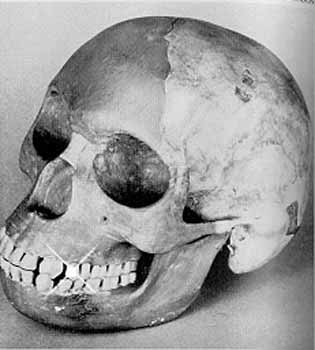
皮尔当人是次有名的骗局,多块头骨和颚骨于1912年被发现,并被认为是早期人类化石的遗骸。样本按其采集者的名字查尔斯·道森(Charles Dawson)被授予了一个拉丁名(Eoanthropus Dawson)。1953年该骗局被曝光,人们在其中发现了猩猩的颚骨和发展成熟的现代人的头骨。
皮尔当骗局大概是史上最闻名的骗局了,使其如此闻名的原因有二:一是它使人们开始关注进化论,二是人们发觉它是个骗局所耗的时间(约40年之久)。
The Piltdown Man is a famous hoax in which pieces of a skull and jawbone found in 1912 were believed to be the fossilized remains of an early form of human being. The specimen was officially given a latin name (Eoanthropus Dawsoni) after its collector Charles Dawson. In 1953 it was exposed to be a fraud consisting of the jawbone of an orangutan and the skull of a fully developed adult man.
The Piltdown hoax is probably the most famous hoax in history. It has become so well known for two reasons: the attention it brought to the issue of evolution, and the length of time (over 40 years) that it took for anyone to discover it was a fraud.
>>点击查看更多关于英语美文的文章

